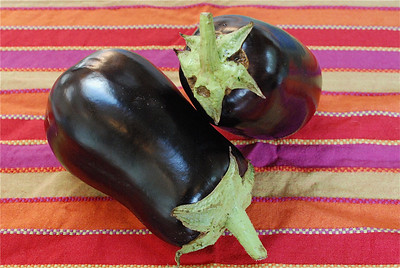As a kid, I loathed eggplant. No wonder. My first taste of it came in the form of a bland and watery eggplant Parmesan. One bite of the floppy, cheese-coated, sauce-logged vegetable and I wrote it off for good. Or so I thought.

A decade later eggplant landed on my plate again. This time, though, it looked far more palatable. In fact, it looked downright delicious. Sliced into strips and then seasoned with olive oil, salt and black pepper, it had been grilled until slightly charred around the edges. A tentative taste left me hooked on its mild tang and supple, melting texture. With that my hatred of the purplish-black, teardrop-shaped veg ended and my love affair with eggplant began.
Known in Great Britain and France as an aubergine, the eggplant – along with the tomato and potato – is a member of the flower-bearing nightshade family. Reputedly originating in China, it first hit European shores during the 13th century. There it became the backbone of such renowned dishes as French ratatouille, Greek moussaka, Spanish escalivada and Sicilian caponata.
Today the Middle East, India and Asia cook with this roly, poly fellow far more than Europe and America do. Lebanon, Syria, Jordan and Israel roast and mash it to create baba ghanoush. Northern India features it in a curry known as baingan bartha while Southern India serves it in a chutney called brinjal kosthu.
Whether I use it in curries, ratatouille, or baba ghanoush or just broil, fry or grill it, I should ensure that my eggplant is young and healthy. Otherwise, no matter what I chose to make, I’ll end up with a spongy, bitter tasting dish.
When searching for a good candidate, I look for smooth, firm, blemish-free skin and an overall heftiness. Once I’ve purchased it, I either use the aubergine immediately or store it in my vegetable crisper for up to four days. By the fourth day it invariably begins to wither and should be composted.
Young eggplant doesn’t need to be skinned. Simply slice and cook it as you would squash. Keep in mind, though, that it will readily absorb oil so either employ oils sparingly or coat your eggplant with batter or bread crumbs before cooking.
Although available year-round, eggplant peaks in late summer. Needless to say, now is the perfect time to drop by your local farmers’ market and pick up a few.
RATATOUILLE
Serves 4 to 6
¼ cup olive oil
1 medium eggplant, peeled and cut into 1-inch cubes
2 zucchini, washed, sliced and then cut into quarters
2 tablespoons olive oil
1½ cup yellow onions, chopped
2 green bell peppers, washed and cut into 1-inch squares
5 cloves garlic, chopped
1 teaspoon sea salt
1/2 teaspoon ground black pepper, or to taste
1½ cup of canned, diced, organic tomatoes
dried oregano, to taste
¼ cup fresh basil, washed and finely chopped
Heat the oil in a large Dutch Oven. Add the zucchini and eggplant and cook until golden and tender, about 10 minutes. Add the onions and 2 tablespoons olive oil and cook until softened. Add the peppers, garlic, salt and pepper and cook for 5 to 10 minutes.
Add the tomatoes and oregano. Reduce the heat to low and cook until everything is soft and well-blended. Sprinkle with fresh basil, stir and serve with slices of crusty baguette.